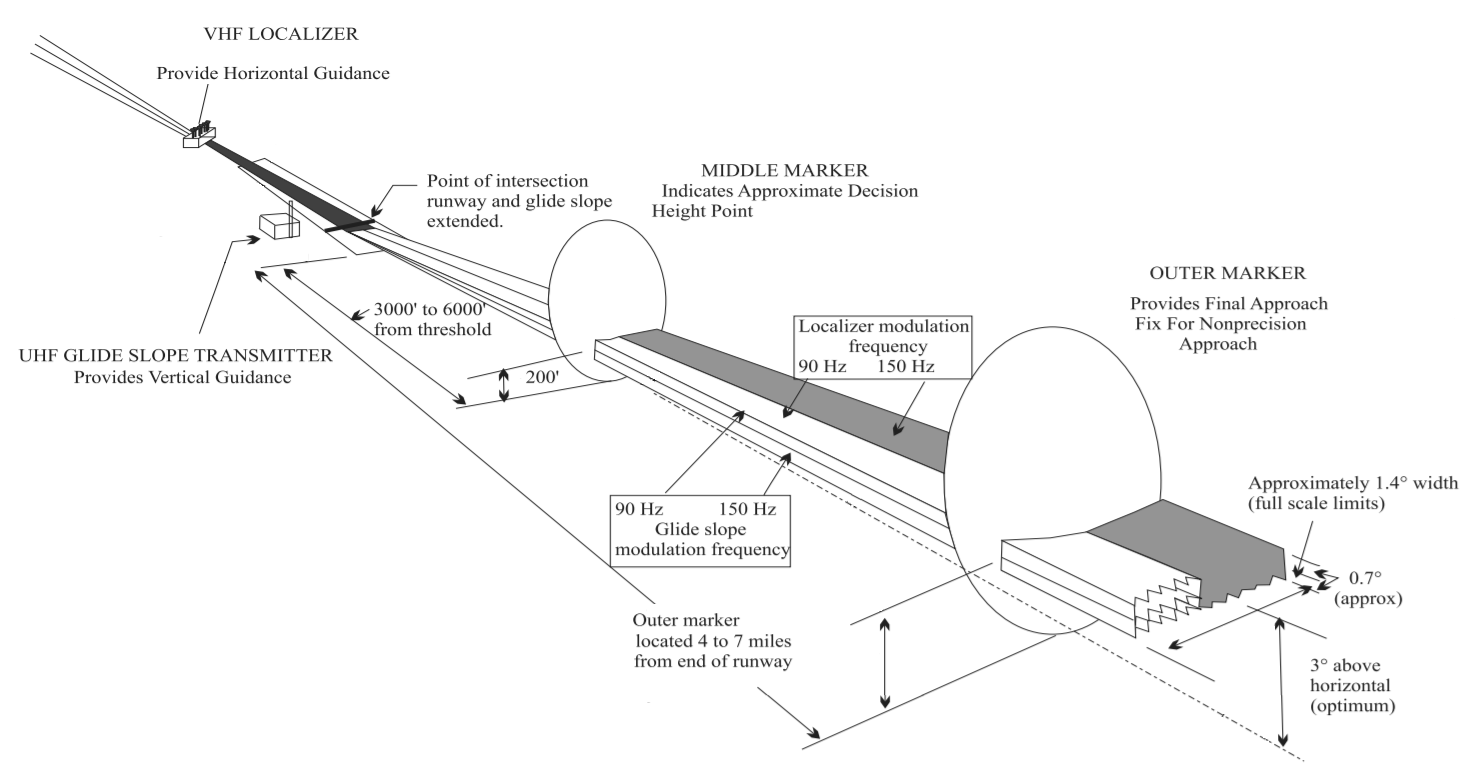|
Distance Measuring Equipment
In aviation, distance measuring equipment (DME) is a radio navigation technology that measures the slant range (distance) between an aircraft and a ground station by timing the propagation delay of radio signals in the frequency band between 960 and 1215 megahertz (MHz). Line-of-visibility between the aircraft and ground station is required. An interrogator (airborne) initiates an exchange by transmitting a pulse pair, on an assigned 'channel', to the transponder ground station. The channel assignment specifies the carrier frequency and the spacing between the pulses. After a known delay, the transponder replies by transmitting a pulse pair on a frequency that is offset from the interrogation frequency by 63 MHz and having specified separation.''Annex 10 to the Convention on International Civil Aviation, Volume I – Radio Navigation Aids''; International Civil Aviation Organization; International Standards and Recommended Practices. DME systems are used worldwide, ... [...More Info...] [...Related Items...] OR: [Wikipedia] [Google] [Baidu] |
Identification Friend Or Foe
Identification, friend or foe (IFF) is an identification system designed for command and control. It uses a transponder that listens for an ''interrogation'' signal and then sends a ''response'' that identifies the broadcaster. IFF systems usually use radar frequencies, but other electromagnetic frequencies, radio or infrared, may be used. It enables military and civilian air traffic control interrogation systems to identify aircraft, vehicles or forces as friendly and to determine their bearing and range from the interrogator. IFF is used by both military and civilian aircraft. IFF was first developed during World War II, with the arrival of radar, and several friendly fire incidents. IFF can only positively identify friendly aircraft or other forces. If an IFF interrogation receives no reply or an invalid reply, the object is not positively identified as foe; friendly forces may not properly reply to IFF for various reasons such as equipment malfunction, and parties in the ar ... [...More Info...] [...Related Items...] OR: [Wikipedia] [Google] [Baidu] |
Instrument Landing System
In aviation, the instrument landing system (ILS) is a precision radio navigation system that provides short-range guidance to aircraft to allow them to approach a runway at night or in bad weather. In its original form, it allows an aircraft to approach until it is over the ground, within a of the runway. At that point the runway should be visible to the pilot; if it is not, they perform a missed approach. Bringing the aircraft this close to the runway dramatically increases the range of weather conditions in which a safe landing can be made. Other versions of the system, or "categories", have further reduced the minimum altitudes, runway visual ranges (RVRs), and transmitter and monitoring configurations designed depending on the normal expected weather patterns and airport safety requirements. ILS uses two directional radio signals, the ''localizer'' (108 to 112 MHz frequency), which provides horizontal guidance, and the ''glideslope'' (329.15 to 335 MHz frequenc ... [...More Info...] [...Related Items...] OR: [Wikipedia] [Google] [Baidu] |
Morse Code
Morse code is a method used in telecommunication to encode text characters as standardized sequences of two different signal durations, called ''dots'' and ''dashes'', or ''dits'' and ''dahs''. Morse code is named after Samuel Morse, one of the inventors of the telegraph. International Morse code encodes the 26 basic Latin letters through , one accented Latin letter (), the Arabic numerals, and a small set of punctuation and procedural signals ( prosigns). There is no distinction between upper and lower case letters. Each Morse code symbol is formed by a sequence of ''dits'' and ''dahs''. The ''dit'' duration is the basic unit of time measurement in Morse code transmission. The duration of a ''dah'' is three times the duration of a ''dit''. Each ''dit'' or ''dah'' within an encoded character is followed by a period of signal absence, called a ''space'', equal to the ''dit'' duration. The letters of a word are separated by a space of duration equal to three ''dit ... [...More Info...] [...Related Items...] OR: [Wikipedia] [Google] [Baidu] |
Channel (communications)
A communication channel refers either to a physical transmission medium such as a wire, or to a logical connection over a multiplexed medium such as a radio channel in telecommunications and computer networking. A channel is used for information transfer of, for example, a digital bit stream, from one or several '' senders'' to one or several '' receivers''. A channel has a certain capacity for transmitting information, often measured by its bandwidth in Hz or its data rate in bits per second. Communicating an information signal across distance requires some form of pathway or medium. These pathways, called communication channels, use two types of media: Transmission line (e.g. twisted-pair, coaxial, and fiber-optic cable) and broadcast (e.g. microwave, satellite, radio, and infrared). In information theory, a channel refers to a theoretical ''channel model'' with certain error characteristics. In this more general view, a storage device is also a communication channel, ... [...More Info...] [...Related Items...] OR: [Wikipedia] [Google] [Baidu] |
Flight Inspection
Flight inspection refers to the periodic evaluation of navigational aids used in aviation, such as flight procedures and electronic signals, to ensure they are safe and accurate. Unlike flight tests, which analyze the aerodynamic design and safety of the aircraft itself, flight inspection comprises reviewing flight procedures (such as routes, approaches and departures) to ensure navigational support is sufficient, there are no obstacles and the procedure is reliable. Flight inspectors originally tested the accuracy of light beacons sighted while flying. These beacons allowed pilots to fly at night with visual guidance. Radio navigation systems followed, with inspectors testing the radio transmitters while airborne, and then GPS. Customized aircraft are used for flight inspection, with dedicated receivers and sensors to collect data from the navigational aids being inspected. Computers decode the data and compare to the real aircraft position, with results displayed to the inspec ... [...More Info...] [...Related Items...] OR: [Wikipedia] [Google] [Baidu] |


